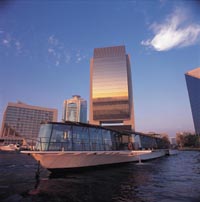In ship shape

THE cruise industry in the Middle East is set for a major explosion if numbers being put out by agents and operators in the region are anything to go by.
Whether operating along Dubai’s creek or booking for international vacations, companies are reporting bigger numbers and better bookings. Across the board in 2003, companies closed anywhere from 70 to 120 percent up on 2002. And 2004 only looks like it will get better.
Says Salah El Khayat, executive director, Danat Dubai Cruises, “With the political situation in the Middle East now stabilising, figures are showing that tourism is up and Dubai is experiencing an influx of executive travellers as well as package and independent tourists. We are continuing with the expansion of its fleet in order to cater for the demand it is seeing.”
That’s a trend that’s reflected worldwide. A record 9.52 million guests around the globe enjoyed cruise vacations in 2003, an increase of over 10 percent on 2002 figures. Industry passenger figures have shown an average 8.4 percent growth annually since 1980.
“The impressive 2003 figures demonstrate the broad appeal of cruise vacations, cruising flourished despite significant obstacles including SARS, terrorism fears and an uncertain economy,” says Robin Maclear, managing director of The Cruise Line, which is opening offices in the region next month.
The forecast for 2004 is 10.6 million guests, a further 11.5 percent increase equating to 1.1 million guests. It is estimated that 5.3 million of these will be first time cruisers.
The increase is due largely to the wide range of cruise products on the market, whether in terms of theme cruises, or in the sheer range of time options available, from a few hours to a couple of weeks. Between 2002 and the end of 2004, 40 new ships will have been introduced bringing an additional 26,687 new beds to the market.
Then, the destinations ships cruises to have moved beyond the more traditional Baltic, Mediterranean and Caribbean to such spots as Australia, South America and Alaska.
Finally, the image of cruising has changed over the last 20 years. From being seen as a pursuit of the rich and the mature travellers, a far wider range of ships is now available to satisfy niche markets and budgets alike. Nearly every shipping line offers hobby cruises with a diverse range of topics, including classical music, bridge, antiques, golf and languages.
Within the region, however, shorter cruise rides, such as the rides on Dubai’s creek, are as popular as getaways or longer-term holidays. Says Debbie Summers, regional manager, marketing and communications, Royal Caribbean Arabia, “We’re delighted to report high early booking demand in our GCC markets. Much of this is coming from repeat guests.”
Adds Bateaux Dubai general manager Patrice Douce, “One area of the market that’s fast opening up is the business visitor, looking to hire boats as marketing venues for product launches or looking to charter cruises to entertain corporate clients.”
As Dubai – and the region – becomes a leading tourism destination, many tourists returning on repeat visits look for different entertainment options. “The trend in reality is that Dubai attracts an incredible mix of visitors from all over the world, with various expectations in terms of standards and prices. However, their overall expecations are rising in terms of quality, variety and sophistication,” says Douce, whose Al Minsaf aims at filling the gap for the 5-star dining experience along the waterfront.
The Dubai Creek, he says, and this could well apply for the entire Gulf coast, has been under-exploited in terms of tourism potential and needs a more aggressive promotion by everyone involved.
Already, the immense activity on new marinas in the region is sign that governments have recognised that potential – but there’s a long way to go yet.
